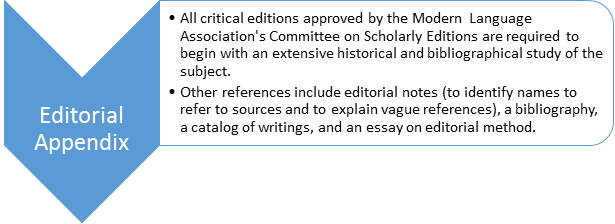
All critical editions approved by the Modern Language Association’s Committee on Scholarly Editions (CSE) are required to begin with an extensive historical, biographical, and bibliographical study on the subject. The editorial references are listed above, but there are many things that go into editorial materials and the critical edition as a whole.
The full list is as follows: Acknowledgements, Introduction, Chronology, Appendix, Editorial Appendix (which includes the Notes to the Text and the Textual Record), and the Index.
The Acknowledgements contain a short history of The Santayana Edition as well as comments on the people or institutions who have helped in the process of creating the critical edition. Those people or places are often publishers, graduate students, faculty, contributing institutions (such as IUPUI).
The Introduction includes information about Santayana’s work as a whole, but also about the specific work. The scholar who writes the introduction comments on how Santayana’s work was received in his time, what it means for philosophy, and how his work is regarded today.
The Chronology is, essentially, a timeline of Santayana’s life and work.
The first Appendix contains a list of variants, including an introductory paragraph explaining what the list of variants contains and why it is necessary that the list is included in the volume. The Editorial Appendix contains an explanation of the purpose of and what is included in an Editorial Appendix, a Sigla (abbreviation) and Symbols section, a Bibliography section, Notes to the Text, and a Textual Record. All sections include an explanation of their purpose. For example, the Sigla and Symbols section contains a list of the abbreviations and symbols used in the text.
The Bibliography section is a list of references to Santayana’s works.
The Notes to the Text contains a list of standard sources used for researching and defining references and annotations. Since The Santayana Edition does not use footnotes in favor of a clear text, the Notes to the Text section briefly explains references Santayana makes to figures, terms or phrases, quotations or allusions, titles of works, and places that a reader might need clarified either because they refer to a specific discipline that might be outside of the general reader’s purview or because they are obscure or archaic terms, for example. The sources of direct quotations or allusions are, of course, noted.
The Textual Record section of the volume includes a Textual Commentary, Discussions of Adopted Readings, a List of Emendations, Reports of Line-End Hyphenations, and a List of Variants. The Textual Commentary explains why, in certain readings, emendations are not made. It also explain Santayana’s revisions. The Discussion of Adopted Readings explains why certain lines were emended, or why they were not. The List of Emendations offers a record of all revisions made by the project editors. The Report of Line-End Hyphenation contains a list from the copy-text that shows the forms of possible compound words that were hyphenated at the ends of lines. It also lists which of those possible forms were kept for the critical edition. Finally, the List of Variants contains a record of every variant between two forms of the text published in the pages of the critical edition.
